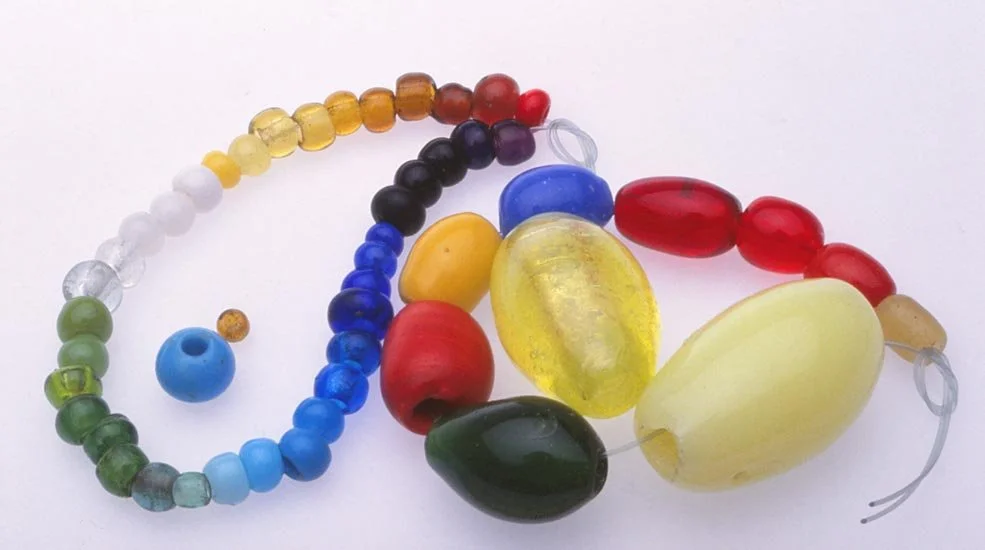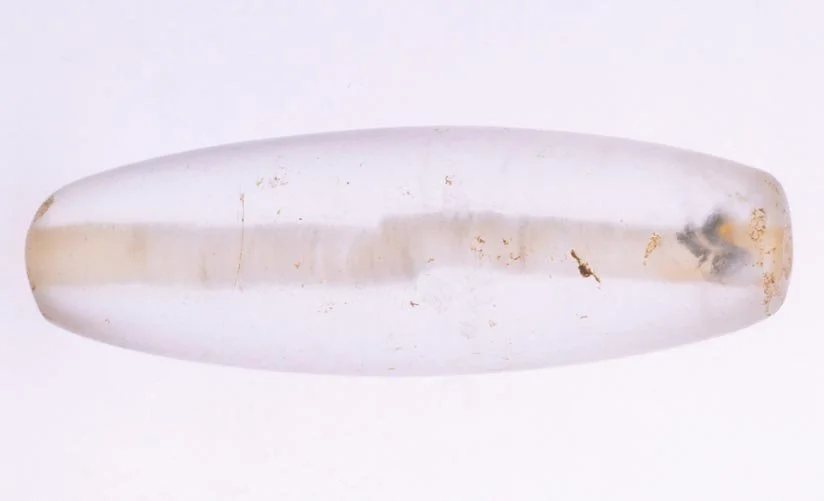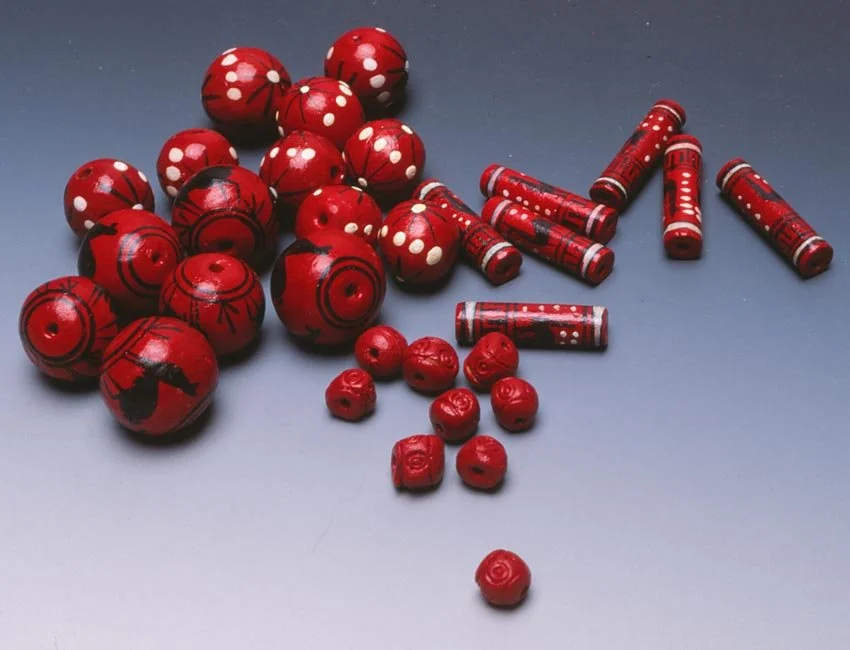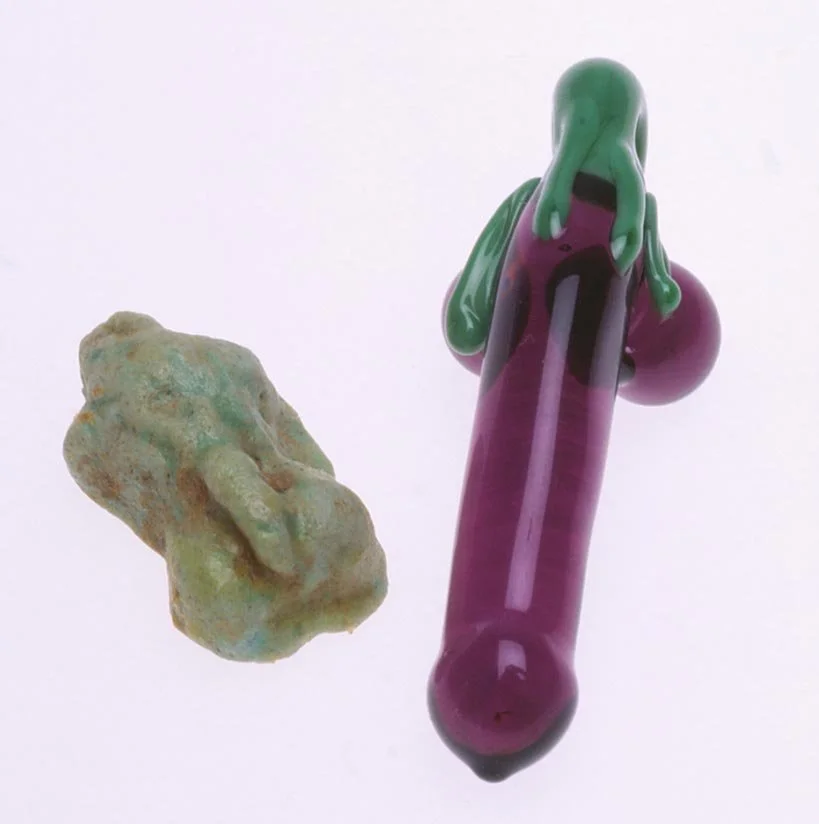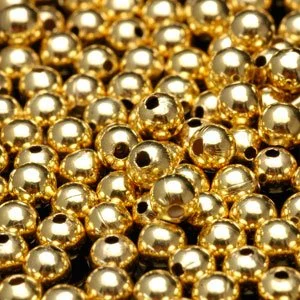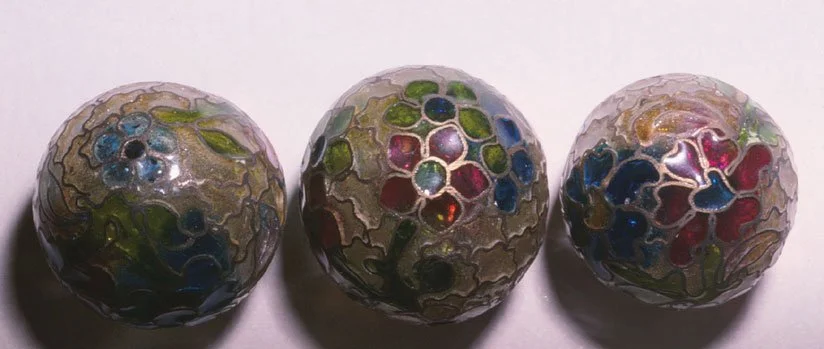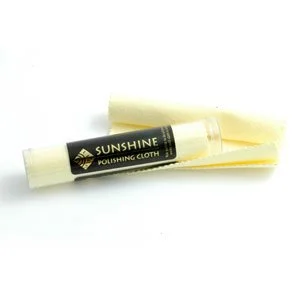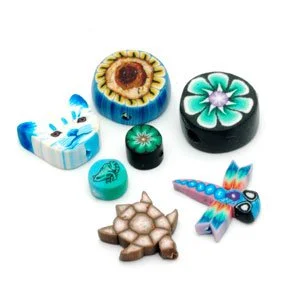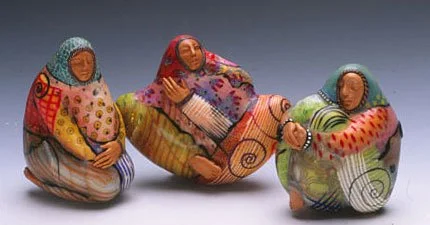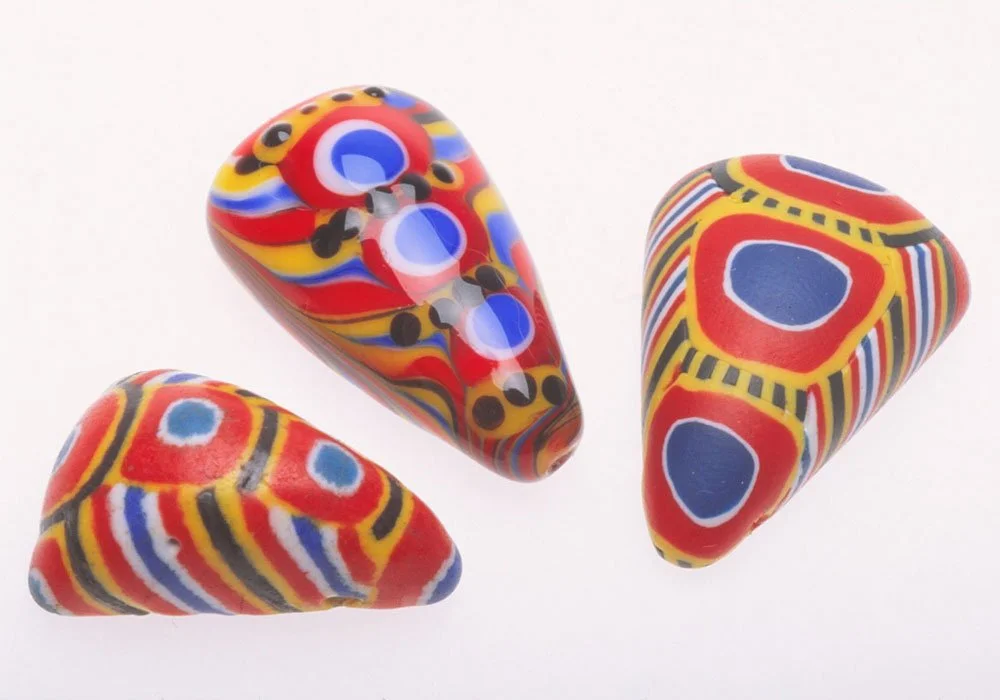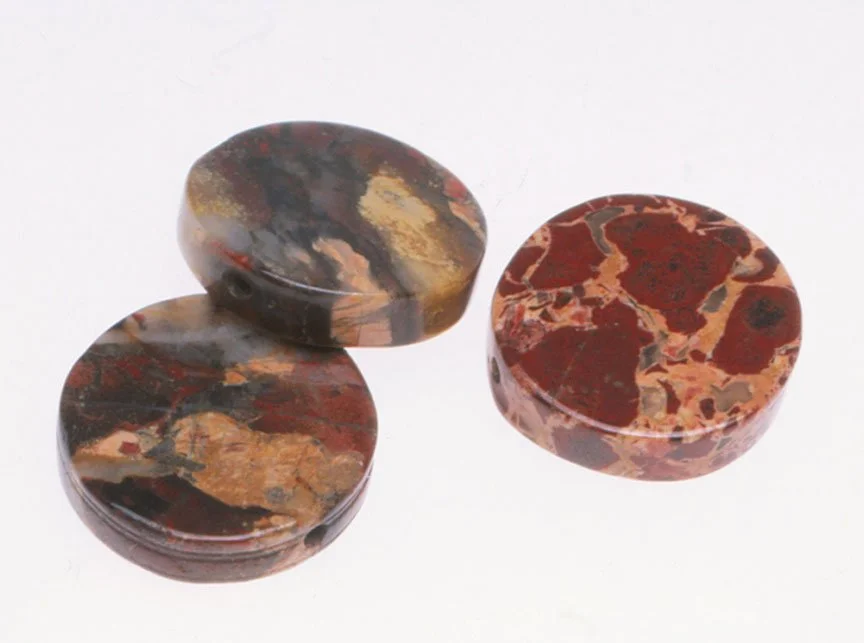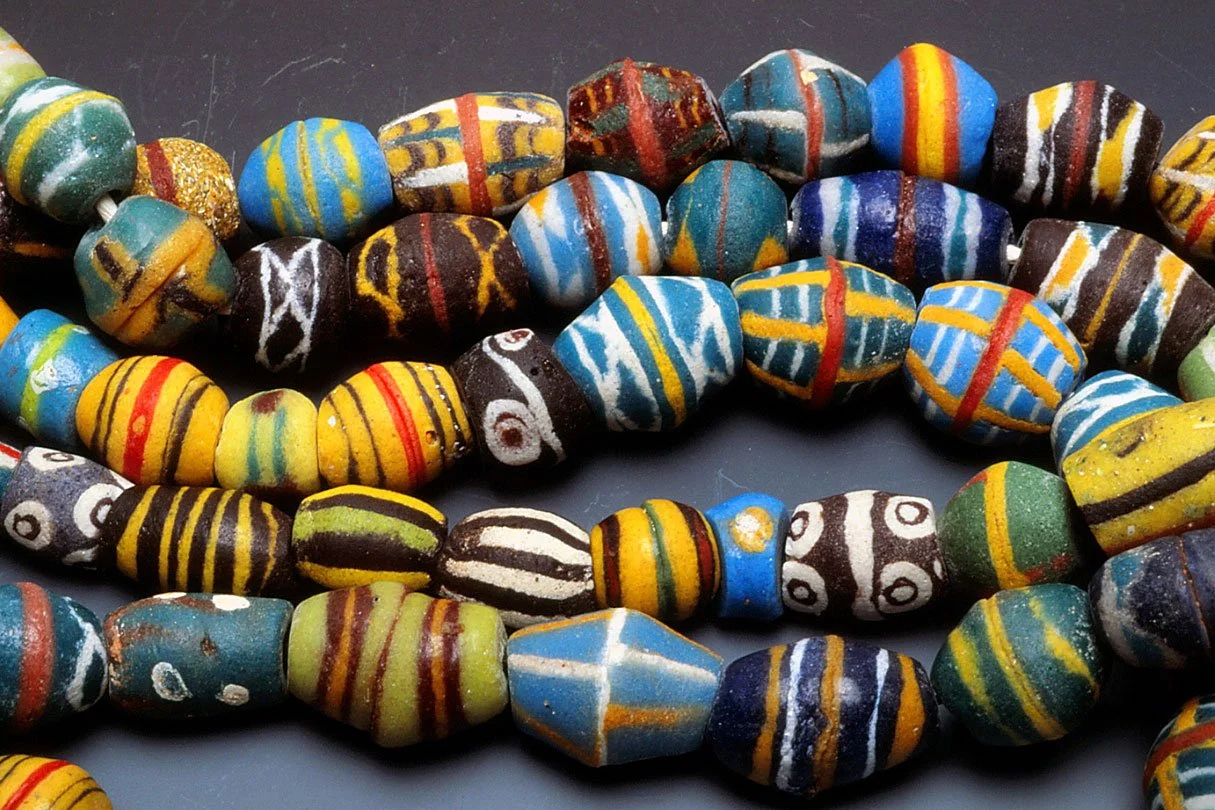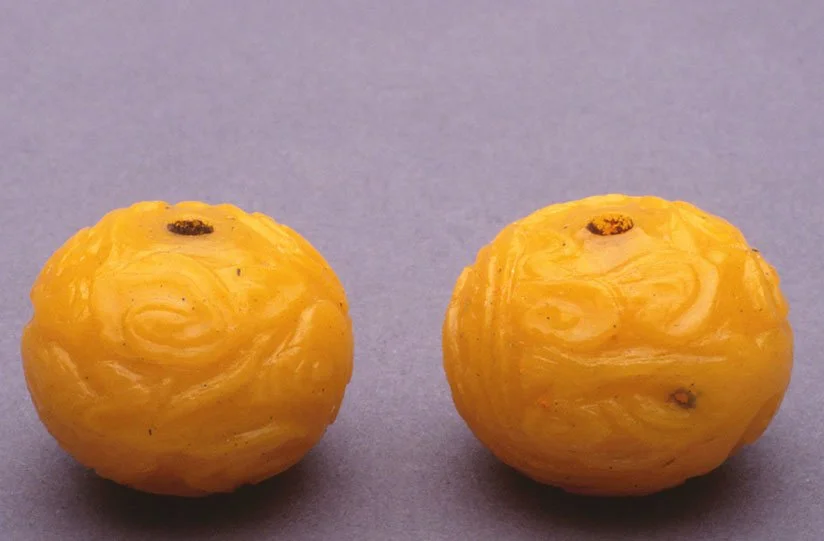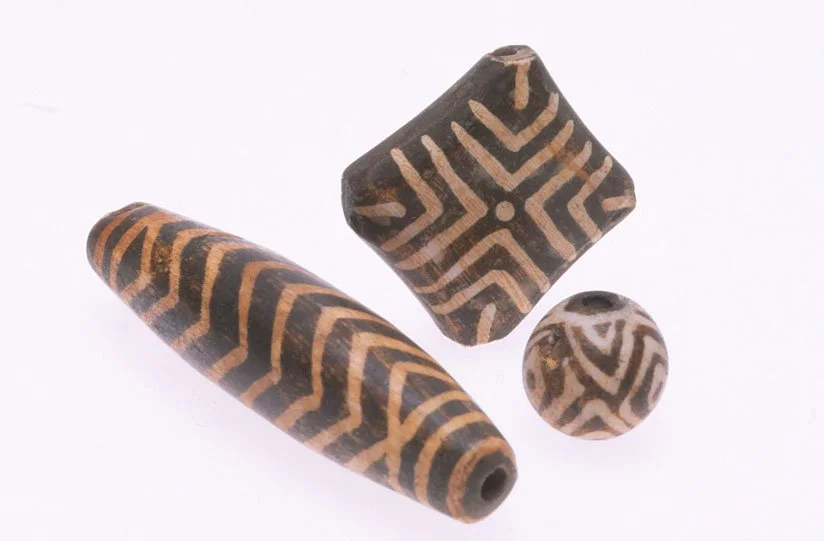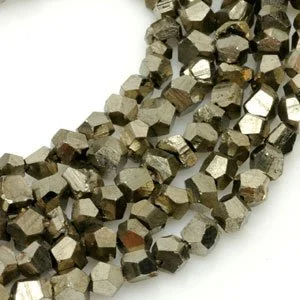Bead Dictionary Letter P
Introduction
In the late 1990s, Penny Diamanti, Joyce Diamanti and Robert K. Liu started working on a Bead Dictionary. Around 2009, after much work by the Diamantis, the Bead Dictionary was posted on the Beadazzled website. Through the years, additions were made by Beadazzled. In the summer of 2018, when the Washington DC Beadazzled store and its website closed, the Bead Dictionary was offered to Ornament. This is a unique resource, especially rich for information on beads of ethnographic and ancient origins. As Ornament has only a staff of three, we are slowly reposting it on our website, updating or expanding some of the entries and are adding search features, links and references as time permits. The Bead Dictionary covers primarily beads and other perforated ornaments, but also tools and materials used by those who make jewelry utilizing beads. Photographs from the Ornament archives are being added, as well as new images taken expressly for the Bead Dictionary and others are being brought up to current standards, as many of these images are almost 30 years old. Original photography was by Robert K. Liu, while Cas Webber did additional photos for Beadazzled, noted in the captions as RKL or CW, after first captions.
This Dictionary of Beads is a labor of love and a work in progress. We welcome your comments and suggestions through the Contact link. To navigate, select from the visual index above to jump to the letter you want in the Dictionary, but give the page a little time to load first. To get back to the top and select another letter use the arrow button. We are continuously adding to the Dictionary, so check back often.
To search for keywords in Dictionary headings, use your browser's search function; for example in Internet Explorer use Control+F and in Apple Command+F, then type in your keyword. We hope you enjoy this (not-so-tiny) treasure, and learn more about the vast world of Beads.
P’Leather®
9/27/2009 : 9/27/2009 modified
See: Imitation Leather
Paternoster Beads
10/27/2009 : 10/27/2009 modified
See: Chevron Beads
Pearls
Various shapes and colors of contemporary Chinese freshwater pearls. Robert K. Liu
Whole volumes have been written about pearls, almost certainly the first gem collected and worn by humans. For more information about these lovely organic gems see Bibliographies in the Reference Section. A short abstract on this vast subject follows.
How Pearls are made
Pearls are the only gems created by a living organism. Any freshwater or marine mollusk can form pearls, but throughout history a few species have predominated. They include mussels, oysters, clams, conch and abalone.
These delicate creatures have no skeleton nor any scales or fur to protect them. They build their homes around themselves by secreting layer upon layer of smooth, lustrous calcium carbonate. We call this substance nacre if it surrounds something in the body of the animal and mother-of-pearl if it covers the inside of the shell or anything attached to the inside of the shell.
Mollusks feed by opening their shells and filtering nutrient-rich water. If an irritating bit of rock, shell, or organic matter gets inside and bites into their body they will surround it with nacre, eventually forming a pearl. This process can take years and almost always results in odd shaped (baroque) pearls. Round pearls were extremely rare and commanded exorbitant prices in antiquity, making them a sign of wealth and/or nobility.
More than 2000 years ago Indians and Arabs dived for oysters primarily in the Persian Gulf along the coasts of India and present day Sri Lanka and in the Red Sea. The Chinese have a long history of harvesting pearls from freshwater rivers and ponds, while early Japanese pearls came from ocean waters. One author estimates that 100,000 oysters from Bahrain would be required to get enough pearls for one necklace!
Various colors and shapes of freshwater pearls. Cas Webber
Cultured Pearls
Clearly there was a demand for a less costly alternative and several Japanese entrepreneurs developed and patented methods for creating cultured pearls around 1900.
Basically the technique involves implanting a mother of pearl object of the desired shape and size into the mollusk along with a piece of mantle (flesh from another mollusk). This triggers the response to cover the implanted object with nacre. The longer this process is allowed to go on, the thicker the nacre and the more lustrous and valuable the pearl. By the 1920s and 1930s the process had been perfected and beautiful and affordable pearls replaced natural pearls in jewelry for everyone except a few serious collectors, members of some religious sects and Arabs who can afford their strong preference for natural pearls.
Although Kokichi Mikimoto did not invent the process of culturing pearls he helped perfect it and worked tirelessly to market cultured pearls around the world. Japanese akoya oysters (Pinktada imbricata) produced lovely, but relatively small cultured pearls. In the 1960s fashion demanded larger pearls and the Japanese formed partnerships with Australians and others across the south Pacific to culture pearls in larger mollusks that inhabited these warmer waters.
Lake Biwa near Kyoto gave its name to Japan’s freshwater pearls, and for a time to all freshwater pearls on the market. Pollution has taken its toll on both freshwater and saltwater pearl production in Japan and since the 1980s China’s pearl output has surpassed Japan’s. Japan continued to sort, string, and market pearls from all over Asia for a while, but is now losing its grip on the industry as Australians, Tahitians, and most importantly the Chinese take over distributing their own pearls.
The most important measure of a pearl’s quality is the thickness of the nacre. The longer the implanted item is left in the mollusk, the thicker the nacre and the more lustrous and durable the pearl. Four years guarantees a thick coat of nacre, but today many Chinese pearls are harvested in less than a year.
White freshwater pearls from China. Cas Webber
What to look when buying pearls
As always you get what you pay for. The value and cost of pearls are related and are determined by the following factors:
Luster—the highest luster looks best and will wear the longest. It takes longer to make so it costs more to buy.
Shape is more a matter of taste than a measure of quality, but perfectly round pearls remain the most desirable and therefore command the highest prices.
Color preferences vary from country to country. Americans in general prefer pale pinks, while Europeans buy mostly cream and white pearls. Middle Easterners and South Americans in general value cream and gold pearls most highly.
Rare, large Tahitian black pearls command the highest prices around the world. Minerals in the water and variations among the mollusks producing the pearls determine subtle natural colors including pinks, cream, gold, and gray.
Darker bronzes, browns, iridescent greens, grays, and blues can be achieved with heat treatments sometimes referred to as irradiating.
Dyes produce bright, often interesting, but unnatural colors such as cranberry red, bright greens, blues, yellows and even purples.
Size also affects price. The quality of the luster being equal the bigger the pearl, the higher the value and price. However, it is possible to buy larger pearls that have an irregular shape and minimal luster that cost less than smaller pearls with high luster and perfectly round shapes. Select your pearls based on the features that are most important to you, and buy from reputable dealers so you know you are getting what you pay for.
Caring for your pearls
Possibly the most delicate gems, pearls require special care. They do best in steady medium humidity and must be protected from acids including those found in perfumes, hair products, cosmetics, bleach, detergents and cleaning products of all kinds, swimming pool water, and most other chemicals. Avoid steamers, ultrasonic jewelry cleaners, high heat of any kind, and don’t even think about putting your pearls in the dishwasher! Ranking between 2.5-4.5 on the Mohs hardness scale, pearls can be scratched by just about anything including metal, glass, and most other gems. Store pearls wrapped in a soft cloth to protect them from other items in your jewelry drawer. Professional jewelers recommend wiping your good pearls with a dry or damp cloth after each wearing to remove traces of perspiration or chemicals and suggest restringing pearls with knots between them every two years, or more often if you wear them a lot. Inexpensive pearls can of course be treated more casually.
9/27/2009 : 9/27/2009 modified
Pearls—Freshwater
Information to come...
9/27/2009 : 9/27/2009 modified
Peking Glass
Various Chinese Peking glass beads. Robert K. Liu
Assorted Chinese Peking glass beads. Robert K. Liu
Information to come...
9/27/2009 : 9/27/2009 modified
See Also: Chinese Glass Beads
Perforation
Crystal bead showing perforation drilled from both ends. Robert K. Liu
Information to come...
9/27/2009 : 9/27/2009 modified
Peridot
Indian peridot beads. Cas Webber
Peridot is a vibrant, translucent green stone that has been known for over 4,000 years. Ancient Egyptians gathered and mined peridot on the inhospitable island of Zagbargad. It was a favorite of the Egyptian queen Cleopatra. In the Middle Ages many of the stones brought back to Europe by the Crusaders were passed off as emeralds.
Today, 80 percent of the peridot on the market comes from Arizona. Pakistan also contains some new sources of peridot.
Metaphysically, peridot helps to bring about necessary changes. Use peridot to bless and energize your work, whether it is gardening, raising children, working as a healer, building a business or assisting others in any of these activities. Wear peridot to attract the true love of your life. Peridot is the traditional birthstone for August. The Red Sea deposits remain the most important s Also Burma, the US, Brazil, South Africa, and Norway.
Long associated with the sun, peridot is reputed to possess healing powers, break evil spells, and illuminate occult mysteries. Legend tells that because it glows in the dark peridot was prospected at night on St. John’s island in the Red Sea, and deposits were marked to be mined the next day.
Peruvian Beads
Pre-Columbian shell beads from the Moche culture of Peru. Robert K. Liu
Ancient spondylus shell beads from Peru strung with Nueva Cadiz beads traded by the Spanish conquistadors. Robert K. Liu
Samples of various shapes of Peruvian painted clay beads. Robert K. Liu
Information to come...
9/27/2009 : 9/27/2009 modified
See Also: Chevron Beads From Americas Nueva Cadiz Beads Peruvian Opal
Peruvian Opal
The best pink and blue specimens of common opal are found in Peru and given the name Peruvian opal. Blue-green Peruvian opal reminds one of the colors of the sea.
Metaphysically speaking, blue Peruvian opal calms a restless mind and can bring about more peaceful sleep. Pink Peruvian opal is similar in color to rhodochrosite, but without the distinctive bands. The pink variety of Peruvian opal clears and calms the heart. It also helps those who have excessive fear or anxiety.
Peyote Stitch
Information to come...
10/27/2009 : 10/27/2009 modified
Phallic Pendants—Ancient and Contemporary
Ancient faience scrotum pendant vs. contemporary glass phallic pendant. Robert K. Liu
Certain organs of the human body have had a long history of use as beads, pendants or amulets, such as breast beads, male genitalia and very rarely, their female counterparts. The latter are mostly made by modern artists. Perhaps the most widespread are phallic pendants, which occur in metal, faience and glass in antiquity. Shown here are a faience amulet of the scrotum (1.9 cm long) and a contemporary glass example, by Larry Scott. The faience amulet is found in Italy in Roman times and elsewhere in Iran (Sassanian Persia) or south Russia but very similar ones in glass were in use earlier. Other popular amulets often found with the phallic ones include bunches of grapes and the figa or mano-fica, a very common apotropaic device for Romans.
9/27/2009 : 9/27/2009 modified
See Also: Amulets
Philippine Beads
Information to come...
10/27/2009 : 10/27/2009 modified
See Also: Wood Beads Coconut Shell Disk Beads
Pi
Various gemstone beads in classic Pi shape, commonly known as donuts. Robert K. Liu
Information to come...
10/27/2009 : 10/27/2009 modified
Picasso Beads
“Picasso” beads, contemporary European manufacture. Robert K. Liu
Information to come...
9/27/2009 : 9/27/2009 modified
Pietersite
Four Piertersite briolette shaped beads. Cas Webber
Pietersite contains swirling colors of blue, gold, red, purple, gray and black. It is sometimes called the tempest stone because of its similarity to the colors you may see in a thunderstorm. Namibia, South Africa and China are the major producers of pietersite.
Use pietersite to enhance creativity. Pietersite helps to clear negative energy and destructive patterns while revealing a new direction for your life. With pietersite’s gift of increased power, a person is more likely to go after and achieve his or her goals.
Plated
Examples of various kinds of plated beads including metalized plastic (largest), plated base metal beads and plated beads set with crystals (front center). Cas Webber
Information to come...
10/27/2009 : 10/27/2009 modified
Plated base metal beads. Cas Webber
Platinum
Information to come...
10/27/2009 : 10/27/2009 modified
Pliers
Chain nose pliers. Cas Webber
Left to right: round nose pliers, crimping pliers and cutters. Cas Webber
Round nose pliers. Cas Webber
Information to come...
10/27/2009 : 10/27/2009 modified
See: Chain Nose Pliers Crimping Pliers Cutters Nylon Jaw Pliers Rosary Pliers Round Nose Pliers Split Ring Opener
Plique A Jour
Plique a jour beads. Robert K. Liu
Information to come...
9/27/2009 : 9/27/2009 modified
PMC
9/27/2009 : 9/27/2009 modified
See: Precious Metal Clay
Polishing Cloth
Polishing cloth for safely removing tarnish from metals without damaging stones. Cas Webber
A polishing cloth removes tarnish from metal jewelry without water. The item should be clean and free from dust before polishing. Gently rub the surface with the polishing cloth which is impregnated with chemical cleansing agents and non-scratching micro-abrasives.
Polymer Clay
Mass produced imported polymer clay beads. Cas Webber
Polymer clay beads by Pier Voulkos. Robert K. Liu
Fimo beads by Kathleen Dustin. Robert K. Liu
Polymer clay is a clay-like material made with PVC and other compounds that help create pigment or texture effects. This material was a serendipitous development based on plastics used in other fields, such as doll making and the electrical industry. In the 1960s polymer clay was first used in artistic endeavors. Two of the most popular brands are Fimo and Sculpey.
Polymer clay allows artists to mimic glass bead designs with even greater precision than makers of the original glass beads could achieve. With polymer, the design is set in clay and then cured; the artist does not have to set the design in molten glass. This results in cleaner lines and more symmetrical designs. Compared to the centuries-long history of other materials, the history of polymer clay very young. This material is mere decades old, so we may well see many more creative applications in the beadmaking world.
See Also: Dustin, Kathleen City Zen Cane Hughes, Tory Warring States Beads—Glass Imitations
Polymer Clay Imitations of Other Materials
Polymer beads imitating stones and other bead materials, by Tory Hughes, an artist who pioneered this technique. (1.7 to 6.5 cm long). Robert K. Liu
Authentic Mauritanian kiffa bead; contemporary glass kiffa reproduction; Fimo polymer clay kiffa reproduction. Robert K. Liu
Polymer clay, a kind of plastic, has been used successfully by late 20th century artists to duplicate many natural and synthetic materials. Tory (Victoria) Hughes is among the pioneers in developing imitative techniques with polymer. She has specialized in producing an array of realistic replicas of ancient and ethnographic beads. The image shows excellent imitations of stone, coral, and copal beads. She even imitates the way that pre-Columbian Maya inscribed jade beads and then filled the lines with cinnabar. The simulated coral and copal beads have inlaid turquoise, a practice used among certain Asians, such as Tibetans.
See Also: Polymer Clay
Poppy Jasper
Poppy Jasper coin or dime-shaped beads. Robert K. Liu
Information to come...
9/27/2009 : 9/27/2009 modified
Powder Glass Beads
Powder Glass beads from West Africa. Robert K. Liu
Powder glass striped tube beads. Robert K. Liu
Mauritanian kiffa bead made by powder glass method. Robert K. Liu
Powder glass beads are made from pulverized glass either by a wet-form method, in which a binder is added to help to shape the beads, or by a dry-form method employing molds. The beads are fired in a simple kiln in which the glass is sintered; that is, although the temperatures reached are not high enough to fully melt the glass, the particles are fused into a coherent mass.
Powder glass beads are made almost exclusively in West Africa, where the technique may date back to the 16th century, or even earlier in Mauritania. At first the glass was probably derived mainly from imported glass beads and glass ingots. More recently a principal source of raw material in Ghana has been old jars and bottles—beer bottles for brown and green, cold cream jars for white, milk of magnesia bottles for blue. Metal oxides, sulfur, and other additives produce additional colors. Now plastic packets of pre-ground glass of every hue can be bought in the market.
Today the craft is thriving in Ghana among the Krobo, Ewe, and Asante, who use clay molds to form beads by the dry method. In the more common type of mold, powdered glass is poured into multiple circular depressions, each of which has a stalk of a cocoyam or cassava leaf fixed upright in its center to form a vertical perforation. The beads may be monochrome or have horizontal bands made by layering different colors of glass. Longitudinal stripes are created by sliding a wire or straw down the wall of a hole after filling, then withdrawing it and filling in the cavity with pulverized glass of a contrasting color; spiral stripes are formed by twisting the bead part way through the firing. In another type of mold, powdered glass is poured in a groove, with the stalk that forms the perforation placed horizontally in the middle of the heap.
A popular technique today is to make two solid or hollow powder glass halves and then fuse them together to form a sphere or bicone. Beads may also be decorated by inserting small beads, bead fragments, or other pre-formed glass elements before firing. Some designs replicate patterns created in European glass beads by other methods, such as trailed waves and crosses, impressed eyes, and millefiori motifs.
If fired long enough in a relatively hot furnace, powder glass beads may acquire a glassy finish, but more often they are matte and rather gritty. After cooling they are usually ground and polished on a fine-grained stone to smooth the surface and sometimes shape the beads and bevel their ends. The perforations of powder glass beads are always irregular. The beads range in length from about 4 mm to 50 mm or more. The colors are all opaque and once were typically somber and muted, but today lighter and brighter shades are common.
The method of manufacture and granular texture of Ghanaian powder glass beads have given rise to popular names such as baked beads, pot beads, and sand or sand-cast beads. Among traders they are also known as Ghana glass. Striped or layered beads are called gashi or priest beads, perhaps because they were used in divination. White beads with red and black or other stripes, widely worn as multi-strand waist beads, are called powa by the Krobo, the term they use for chevrons, which these beads resemble. Adjagba, akosu, and bodom beads are large and highly esteemed Ghanaian beads made by the powder glass method.
Sintered glass crumbs have been used to simulate gneiss beads in Ghana and possibly Mali, and coral beads in Nigeria. Some Nigerian powder glass beads may have been formed with the help of a binder, but the finest examples of the wet-form technique are the intricate polychrome Kiffa beads made in Mauritania.
Outside of Africa, Native Americans used crushed glass trade beads to make tab pendants as early as 1680. In 1805 Lewis and Clark reported the manufacture of large powder glass beads by the Mandan. Some thirty years later, the painter George Catlin described these as "a very beautiful and lasting kind of blue glass beads, which they wear on their necks in great quantities."
In the twentieth century powder glass beads have been made from glass scrap in Borneo, while contemporary beads of pulverized glass bound with plastic resin have entered the market from Lebanon as fake ancient beads mixed with real ones.
See Also: Adjagba Beads Akoso Beads Bodom Beads Kiffa Beads Coral Simulations Recycled Bead Materials Simulations and Copies Waist Beads
Power Pro
A pre-waxed, braided bead thread that is both flexible and strong, thanks to new technology. Power Pro has an 8- to 30-pound test strength depending on diameter. Few beads will cut through it. It is one the best cords for working with crystals, metal beads, and bugle beads, but it can be too thick for multiple passes through some of the smallest beads. Cutting it at an angle and waxing the tip can help to thread it through a #12 or #13 beading needle. It knots easily, and it does not stretch.
Pre-Columbian
Pre-Columbian greenstone beads. Robert K. Liu
Inlaid shell beads from the Moche culture of pre-Columbian Peru. Robert K. Liu
Pre-Columbian clay beads depicting coatimundi. Robert K. Liu
Information to come...
9/27/2009 : 2010-09-15 modified
See Also: Greenstone Beads Peruvian Beads Shell Beads Tairona Beads
Precious Metal
The three generally recognized precious metals are gold, silver, and platinum. They are called precious due their rarity and economic value, as opposed to base metals, which are abundant and less valuable. Both precious- and base metals are elements—substances in their purest form. Alloys are combinations of two or more different metals and, in fact, the metals used in beads and jewelry are almost always alloys. Karat gold and sterling silver consist predominantly of precious metal but they are alloyed with other metals to improve their functionality.
Precious Metal Clay
Information to come...
10/27/2009 : 10/27/2009 modified
Prenite
Prenite beads. Cas Webber
Information to come...
10/27/2009 : 10/27/2009 modified
Pressed Glass Beads
Pressed Chinese glass. Robert K. Liu
Pressed Czech glass beads also known as “druks.” Robert K. Liu
Bohemian pressed glass trade beads known as wedding beads or lightbulb beads. Robert K. Liu
Information to come...
9/27/2009 : 9/27/2009 modified
See Also: Bapterosses Beads Bohemian Pressed Glass Prosser Beads Snake Beads Druks Fulani Wedding Beads Molded Glass Beads Vaseline Beads
Prosser Beads
An assortment of glass Prosser beads. Robert K. Liu
Two Englishmen invented the basic process that is used to make Prosser molded beads. In 1840 Richard Prosser patented the process in England, and in 1841 his brother Thomas patented improvements to the process in the US. Both patents were for the manufacture of buttons. Neither of the brothers ever made beads. Prosser beads are also called Bapterosses beads, after a French entrepreneur who further improved on the Prosser method and began making beads in France in the 1860s.
Prosser beads are always opaque, and their ceramic-like finish is often rather crude and grainy. They come in a limited range of colors beyond the standard spectrum of light to dark primary colors, the usual pastels, and a few more exotic hues such as amber and coral. Predominantly spherical or cylindrical and modest in size, they could be described as typical filler beads. Thanks to interchangeable two-part molds, however, Prosser boast a variety of complex shapes, including interlocking beads, such as “snake” beads.
Prosser beads are made with the help of a hydraulic press that can exert the great pressure that is needed to compress a cold, moist mixture of finely pulverized materials into cast-iron molds and form beads. After removal from the mold the beads are dried, then after being fired at a relatively low temperature they may be hand painted or transfer printed, but they are usually left undecorated and monochrome. Finally, they are glazed and fired at a high temperature, similar to the way that porcelain is.
The ingredients of the mixture and their proportions vary, and researchers debate whether Prosser beads should be classified as ceramic—porcelain, in particular—or glass, or a ceramic/glass hybrid. The materials that make up the mixture reportedly include clay or some other earthy material (the basic material of ceramics), flint and feldspar (porcelain ingredients), but also soda and quartz sand (major components of glass). Metallic oxides (used by potters and glassmakers alike) are added to obtain the desired colors. Other beadmakers have added still other ingredients to the mix, most notably milk which was introduced by Bapterosses. It is understandable that Prosser beads are sometimes misidentified as pressed glass beads, or mistakenly called porcelain or earthenware beads. They are also widely known as tile beads, because the same materials and technology are used to make ceramic tiles.
Beads that are made by the Prosser method share several distinguishing features. Mold seams often create pronounced equatorial ridges on spherical beads. Cylindrical beads taper slightly, as do their large perforations, which makes it easier to release them from the mold. A marked difference between the two ends of cylindrical beads is due to the molding process. One end is typically smooth and somewhat rounded, while the other end is flat and displays a pitted “orange peel” surface. In Bapterosses beads, which tend to be more carefully crafted, this tell-tale anomaly may barely be visible except to a trained eye.
After Bapterosses developed a system to mass produce Prosser beads, and thus reduced their cost, they became very popular. Soon other workshops and factories began producing Prosser beads in Bohemia, then in Germany, and possibly in Italy and even in England. Because the beads were inexpensive and uniform in size and shape they became worldwide best sellers. European beadworkers liked to use them to create decorative geometric designs to embellish utilitarian items, such as table mats, trivets, and bell pulls. But most Prosser beads were made for export to the Americas, to Asia, which inspired the name “Oriental Beads” for a line of trade beads, and especially to Africa, where they were used in the regalia of Kuba kings and Luba diviners. The high frequency of Prosser beads found in Zaire, the former Belgian Congo, suggests that they may have also been made in Belgium. The great bulk of them were cylindrical or spherical in various sizes, but some were specifically designed for the African market. The Czechs used the Prosser method to mold imitation conus shell rings, lions’ teeth, and Tuareg amulets. Today these simulations of traditional African ornaments are highly prized collectibles.
In the late 19th and early 20th century, shipments of Prosser beads arriving in African ports rose to hundreds of tons annually. But when plastic beads proliferated in the 1950s and ‘60s, demand for Prosser beads declined, and by the end of the 20th century production of these beads ceased altogether in Europe. They continued to be made in North Africa, however, with old machinery that had last manufactured Prosser beads in the Czech Republic. The equipment had been sold off by weight to a Moroccan company, and in the 1990s it was still turning out tile beads, but in modern matte and muted colors favored by contemporary designers.
9/27/2009 : 9/27/2009 modified
See Also: Bapterosses Beads Bohemian Pressed Glass Pressed Glass Beads Snake Beads
Puka Shells
Necklace of puka shell beads from the 1970s. Robert K. Liu
Information to come...
9/27/2009 : 9/27/2009 modified
Pumtek Beads
Traditional pumtek bead shapes. Robert K. Liu
Pumtek bead diamond shape. Robert K. Liu
With heavy influence from India, the Pyu people of Burma created a patterned bead called pumtek or “buried thunderbolt”. Around 1,000 years ago, these people began using fossilized palm wood as their medium and then adding dark patterns to it. In the early 1900’s the villagers living near an ancient Pyu city began looting the nearby cemeteries and selling off the ancient pumtek beads to Chin villagers from western Burma (Myanmar). When the pumtek beads ran out, the Pyu began drilling decorated blanks and making copies from petrified, but not opalized, hard-grained wood. All are now on the market, but the genuine ones are much more valuable. Genuine pumtek beads generally have dark striations along the sides and dots on the ends which indicate they were made from fossilized palm wood. The imitations have been made since about 1926, but are made from a hard wood with a finer grain that sometimes appears darker and more wood-like.
The Chin people who purchased the beads knew they were getting imitations and paid much less for them. Just before the 1980’s the demand decreased and beadmaking stopped. Because of worldwide demand for the unique pumtek patterning, beadmaking has since resumed. Materials other than fossilized wood are being used with mixed results. Horn and stone are two of the materials that have been tried, but haven’t had the success of the original palm wood.
For some collectors, it may be hard to tell a genuine pumtek bead from a copy. The only sure way to tell involves the use of a short wave UV lamp. If the bead fluoresces, it is an original pumtek bead, if not, it is one of the copies.
9/27/2009 : 9/27/2009 modified
Punch
03/02/2010 : modified
See: Stamping
Pyrite
Pyrite nugget beads. Cas Webber
Pyrite is sometimes called fool’s gold because of its metallic luster and yellow hue. Spain, Italy and Peru contain the most important deposits of this brassy stone. Pyrite can become brittle when exposed to humidity, so keep it cool and dry. In jewelry making, pyrite is a great alternative to silver or gold accents.
Pyrite helps to build up masculine energy. This is beneficial to both men and women who need to be more confident or assertive. Placing pyrite in your office can help you maintain focus and detoxify your environment. Men could wear pyrite to enhance their vitality.



